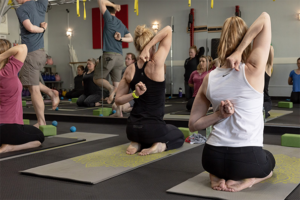The Benefits of Kinstretch
How Can Kinstretch benefit your daily life?
The Benefits of Kinstretch – Being mobile is a crucial and often overlooked aspect of health. If a person does not have the ability to move a joint freely through its full range of motion, then they are already putting themselves at an increased risk of injury before even attempting to pick up a weight and load that range of motion.
Mobility is essential for overall joint health and strength because mobility directly impacts the quality of your movement. The ability to move into a range of motion effortlessly and pain-free is determined by muscles and joints ability to perform within the range of motion they can control actively. Whilst mobility and flexibility aren’t the same, they go hand in hand in allowing the body to move without stress.
Benefits of Kinstretch
 Mitigate your risk of injury– By increasing your ability to control your muscles and joints at end ranges, you decrease your risk of injury. The more strength you develop in your weakest areas, the less risk you have of becoming injured if you get into a compromised position
Mitigate your risk of injury– By increasing your ability to control your muscles and joints at end ranges, you decrease your risk of injury. The more strength you develop in your weakest areas, the less risk you have of becoming injured if you get into a compromised position
- Keeps joints healthy- When performing mobility exercises, the joint being targeted is usually being trained in isolation. This means you are focusing on improving the individual parts of the joint without allowing for compensation from other areas around the body. When we perform rotational movements at end range, blood is moved to the surrounding tissues and synovial fluid (fluid in our joints which helps them glide) is moved into the working joint. For example, When performing Hip. C.A.R’s, blood is transported to the muscles working to move the leg (hip flexors, glutes, external rotators) and synovial fluid hydrates the hip joint in preparation for exercise and daily activity while reducing inflammation in the joint. Look at rotation as nutrients for your joints
- Become stronger- If your range of motion is restricted in the hip when we are performing a squat, when you get towards the end range of movement, you will not be able to control the position which will eventually lead you to not recruiting all the muscle fibers in that area. Less muscle fibers being recruited = less strength.
- All you need is you- In addition to increasing strength and decreasing your risk of injury; mobility exercises are naturally minimalist in nature. Many can be down with just the weight of your body, and the most you would ever need is a few yoga blocks and a tennis ball. With a little education, you can do your mobility exercises anywhere!
So what does mobility training look like?

Well first off let’s all agree on what is not mobility training. Mobility training is not foam rolling, using massage guns, using bands to help you get into positions or passive stretching. Foam rolling has been said to “help break up fascial adhesions around the muscles and help increase joint mobility and optimal muscle contraction.” This is simply not true. I can guarantee that rolling around on a foam roller will not help you actively express range of motion in your joints. If your goal is to increase your usable range of motion, ditch the foam roller.
Now what we know what mobility training is not, let’s talk about what true mobility training is.
A common trait of true mobility training is the use of isometric contractions to help develop maximal body control, flexibility, and usable ranges of motion.
Through the use of these strong isometric contractions at end ranges, our nervous system will learn how to produce high levels of force which will result in significantly stronger joints which will prepare our body for higher force demands. The end goal of mobility training is to build more resilient joints that have the resiliency that improving performance requires while reducing the risk of injury. This is something a foam roller and passive stretching simply cannot do.
The secret to maintaining joint health, and living in a pain free body lies in our ability to actively control the positions we find ourselves in during our day to day life. You don’t need to be the most flexible person in the world, but having active control over movements can help you achieve your goals and improve your overall quality of life.
